Brands and businesses must churn out a plethora of content to engage, educate, and entice their diverse target audiences. However, one of the biggest challenges is ensuring the content gets the maximum reach and impact with minimum resources, effort, and time. This is where the concept of repurposing content for social media comes into play.
Based on the 2023 State of Content Marketing Report by SEMrush, 42% of marketing professionals believe that refreshing and repurposing content plays a pivotal role in the success of their marketing campaigns.
SEMrush
This strategy not only optimizes resource utilization but also enhances SEO, broadens visibility, and fortifies brand recognition.
Therefore, the importance of tailoring content for each platform can’t be overstated. Each social media platform has its unique audience demographic, content preferences, and user behaviors. For instance, what works on LinkedIn – a professional networking site – might not necessarily hit the mark on Instagram, which thrives on brisk visual storytelling.
In this comprehensive guide, let’s dive into the process of repurposing content for social media platforms.
Understanding Each Social Platform’s Audience and Functionality
Effectively repurposing content for social media requires a thorough understanding of nuances involving purpose, audience, and content preference.
1. Instagram

Audience: Primarily millennials and Gen Z, with a slight tilt towards a female demographic.
Content Preference: Highly visual, with photos, videos, and stories taking center stage. Instagram is a platform where aesthetics, brand imaging, and visual storytelling can perfectly blend.
Functionality: Features like Stories, Reels, and Shopping enable varied content formats and purposes.
Tip: Videos that convey their core message in the first three seconds of an ad see a 13% increase in overall breakthrough metrics.
2. Facebook
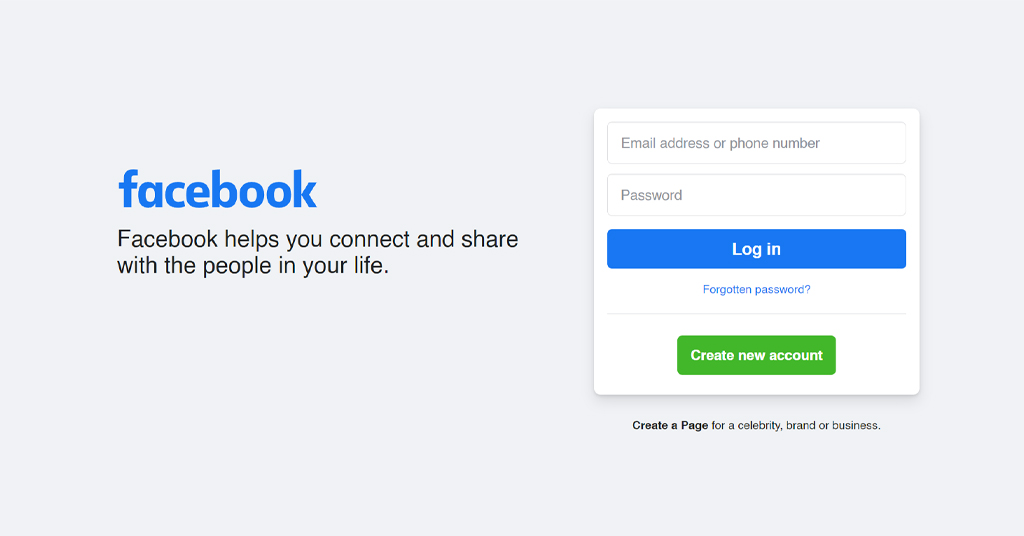
Audience: A diverse age range, but increasingly populated by older millennials, Gen X, and Baby Boomers.
Content Preference: A mix of text updates, images, videos, and shared articles. Facebook Groups also offer a more intimate setting for focused discussions.
Functionality: Facebook Live, Marketplace and the emphasis on community-building tools set this platform apart.
Tip: The vast majority (85%) of Facebook videos are watched without sound. So, adding subtitles in stylized formatting can help.
3. X (formerly Twitter)

Audience: Broad user base, with a significant presence of professionals, journalists, celebrities, and businesses.
Content Preference: Concise text updates (tweets), GIFs, short videos, and threads for longer narratives.
Functionality: Real-time updates, trending topics, and the power of hashtags make Twitter an arena for instant news and discussions.
Tip: Videos shared on X (formerly Twitter) showcasing positive human interactions or desire for a product increase overall response by 40%.
4. LinkedIn

Audience: Professionals and Business Leaders spanning various industries, recruiters, and B2B audiences.
Content Preference: Articles, professional updates, shared industry news, and company insights.
Functionality: Networking tools, job postings, and professional endorsements elevate its professional stature.
5. Pinterest

Audience: Skewed towards females, especially mothers, artists, homemakers, DIY enthusiasts, travel lovers, and those seeking visual inspiration.
Content Preference: Visual pins that lead to blog posts, tutorials, product pages, and other informative sites. Infographics, mood boards, and how-to graphics dominate.
Functionality: The ‘Save’ feature lets users pin content to thematic boards, allowing for personalized content curation. ‘Shop the Look’ and ‘Promoted Pins’ cater to businesses aiming to drive sales and brand visibility.
6. Snapchat
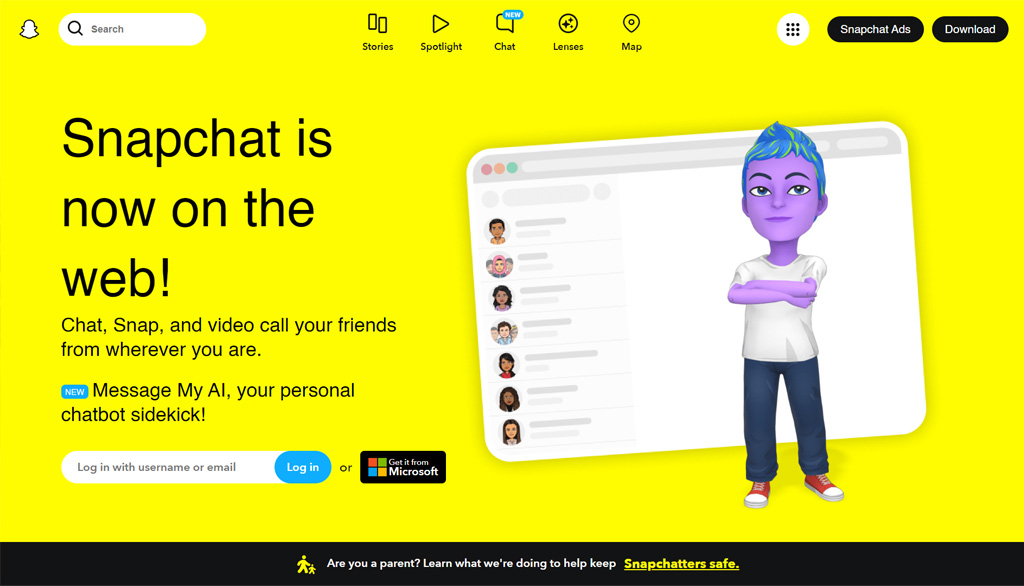
Audience: Primarily Gen Z and younger millennials: an audience seeking spontaneous, ‘in-the-moment’ content.
Content Preference: Short-lived photos and videos (Snaps) are often augmented with filters, text, and drawings. Stories that last 24 hours and Discover content created by brands and influencers.
Functionality: Famous for its AR lenses and filters. Snap Map allows location-based content discovery. The transient nature of content encourages more authentic, real-time sharing.
7. TikTok
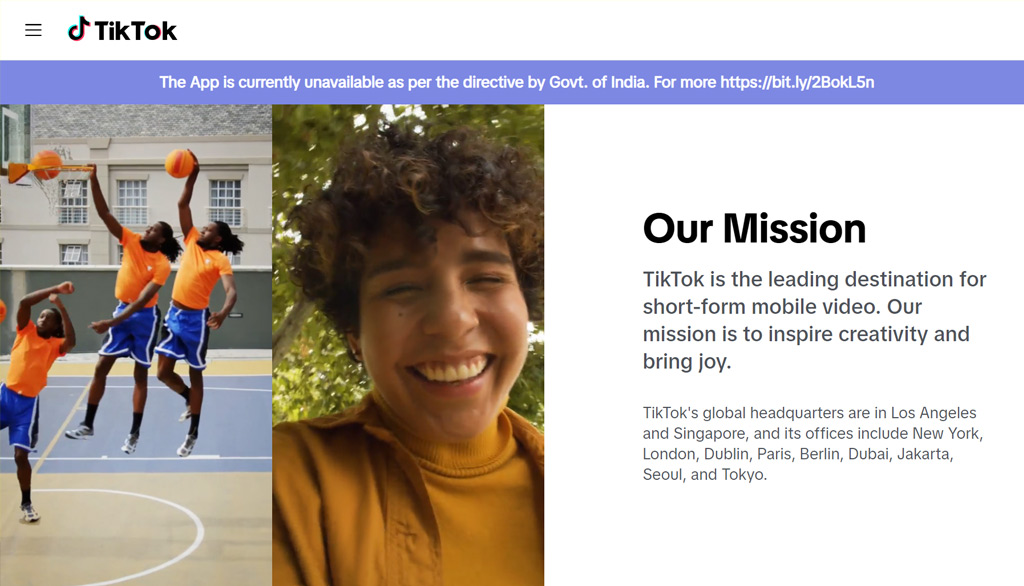
Audience: Dominated by Gen Z but expanding rapidly to include older age groups.
Content Preference: Short-form videos focusing on humor, challenges, dances, and trends—high emphasis on music and sound overlays.
Functionality: In-built video editing tools with various effects, filters, and soundtracks. The ‘For You Page’ (FYP) uses algorithms to personalize content discovery, making virality more accessible for diverse content creators.
8. YouTube
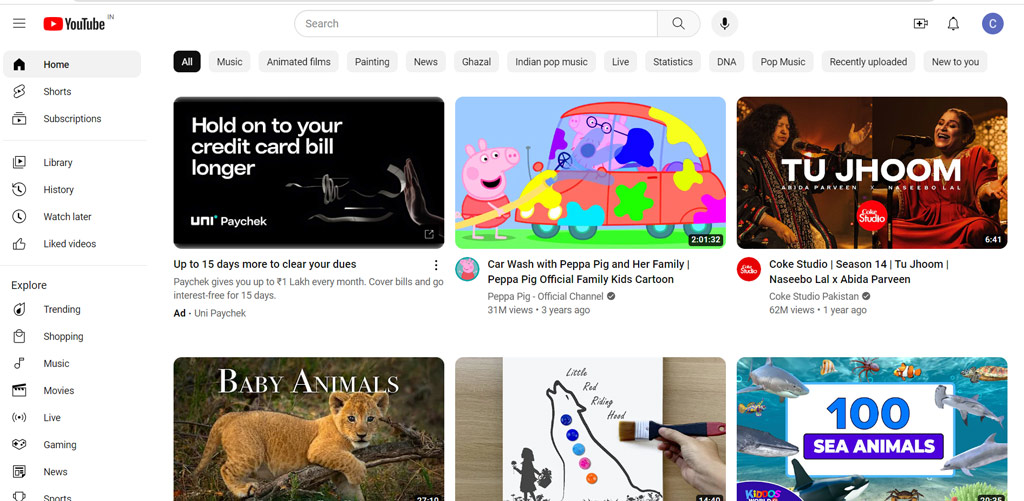
Audience: A broad spectrum of age groups and demographics. This video-led platform also happens to be the second-largest search engine after Google, catering to educational, entertainment, DIY, professional, and virtually every niche audience.
Content Preference: Varied video lengths, from short clips to full-length documentaries. Popular content formats include tutorials, vlogs, music videos, reviews, and web series.
Functionality: Extensive creator tools like YouTube Studio for analytics and monetization. Playlists, Chapters, and Premiere functions offer organized and interactive viewing experiences. The YouTube algorithm emphasizes watch time, making audience retention crucial.
Tip: Social media users are 4 times more likely to use YouTube to research a brand, service, or product than other platforms.
When repurposing content for social media, it’s crucial to dissect each platform’s features and align your content accordingly.
For example, a comprehensive research report might be reshaped into bite-sized statistics for Twitter, infographics for Pinterest, video summaries for YouTube, and a deep-dive article for LinkedIn.
The magic of repurposing content lies in this art of adaptation, ensuring the core message remains consistent while tailoring the delivery to the audience’s preferences.
Step-by-Step Guide to Repurposing Content
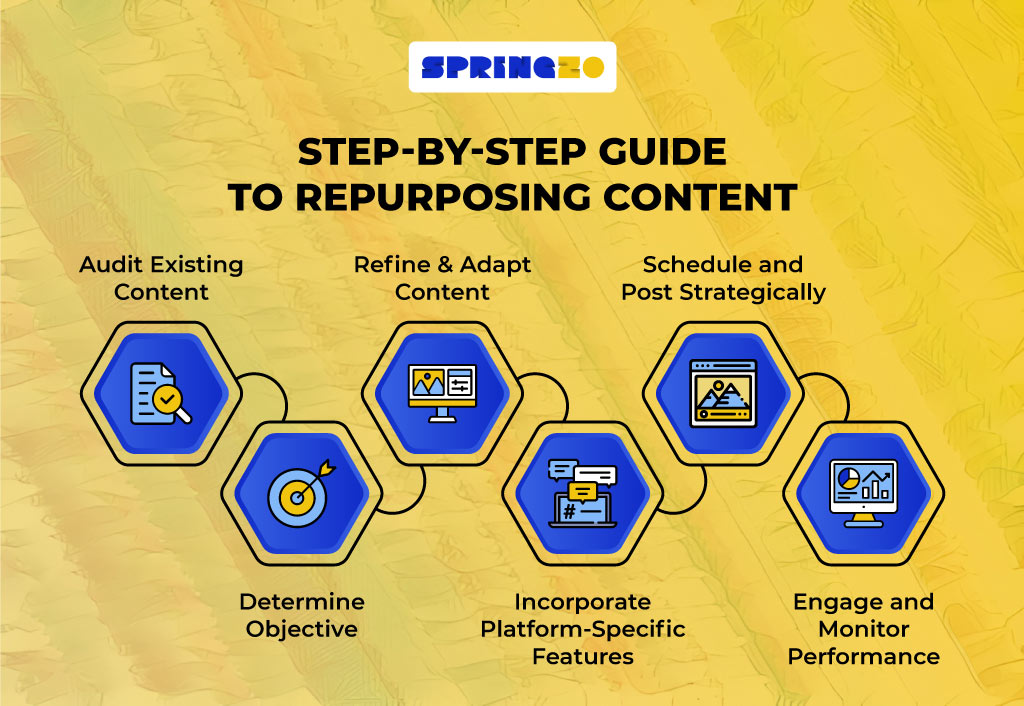
Having understood the benefits of repurposing content for social media, let us shift the focus to the ‘how.’ Here is a detailed breakdown of the strategy:
1. Audit Existing Content
Cataloging and Evaluating Current Assets: The first step of repurposing content for social media is to create an inventory of all your existing content. This can include blog posts, videos, webinars, infographics, podcasts, and more.
Identifying High-Performing Content: Using analytics tools, pinpoint which pieces have garnered the most engagement, traffic, or conversions. These are prime candidates for repurposing.
Example: If a webinar on digital marketing trends was highly attended, consider breaking it down into multiple bite-sized video clips for Instagram or a series of blog posts.
2. Determine Your Objectives for Each Platform
Define Goals: Before repurposing content for social media, identify what you aim to achieve on each platform. Is it brand awareness on Instagram? Thought leadership on LinkedIn? Or community engagement on Twitter?
Match Content’s Purpose with Platform’s Strength: Tailor your repurposed content to leverage the platform’s inherent strengths.
Example: A comprehensive research report could be transformed into visually appealing infographics for Pinterest, while the key insights are shared as discussion points on LinkedIn.
3. Refine and Adapt Content
Adjusting the Tone and Voice: The casual tone that works wonders on TikTok may need more refinement for a platform like LinkedIn.
Modifying Format: Consider the content type that best suits each platform. A long-form article might be best as a video breakdown for YouTube or a carousel post on Instagram.
Resizing Images and Graphics: Each platform has its optimal image dimensions. Ensure your visuals are resized accordingly.
Example: A podcast episode discussing mental health could be repurposed into inspirational quote graphics for Instagram, an article summarizing key points for Medium, and short audio snippets for Twitter.
4. Incorporate Platform-Specific Features
Maximize Engagement Tools: Use hashtags on Twitter and Instagram for better discoverability, CTAs on Facebook posts to drive specific actions, or polls on LinkedIn to engage professionals.
Example: A user testimonial video can be cut into shorter segments for Instagram Stories, making use of interactive stickers like polls or questions to engage viewers.
5. Schedule and Post Strategically
Peak Posting Times: Understand when your audience is most active on each platform. Tools like Buffer or Sprout Social can provide insights here.
Content Calendar: Create a calendar that integrates original and repurposed content, ensuring a balanced content mix.
Example: A week-long campaign promoting an eBook could involve sharing a tip a day on Twitter, a chapter summary every two days on LinkedIn, and interactive quizzes related to the eBook content on Facebook.
6. Engage and Monitor Performance
Stay Active in the Comments: Repurposing content for social media is not enough. Routinely engage with users interacting with your repurposed content. This can provide insights into what resonates and what needs tweaking.
Analyze Metrics: Use platform analytics to assess how your repurposed content is performing. This will guide future efforts and refinements.
Example: If an Instagram carousel post, repurposed from a blog post, receives high engagement, consider creating similar content in the future.
As you navigate this process, remember to keep the core brand message intact while innovatively catering to diverse digital landscapes.
Benefits of Repurposing Content for Social Media
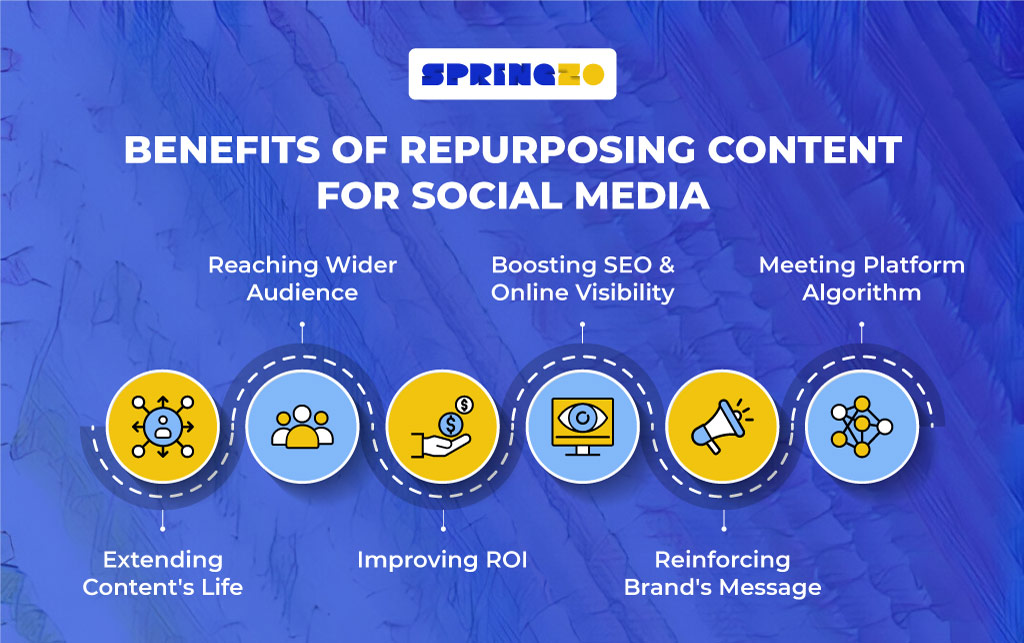
Here are the key benefits of repurposing content for social media.
1. Extending the Life of Your Content
Every piece of content—a blog post, podcast episode, or video—requires a substantial investment of time, effort, and resources. By repurposing, you squeeze more value out of that initial investment, maximizing ROI and allowing a single piece of content to serve varied audiences over extended periods.
2. Reaching Different Audience Segments
Different social platforms cater to distinct demographics and interests. Repurposing content for social media ensures that your message reaches a more diverse set of users.
For example, a visual infographic might engage a younger audience on Instagram, while the data behind it could spark discussions on LinkedIn among industry professionals.
3. Improving ROI on Content Creation Efforts
Content creation can be resource-intensive. Repurposing allows brands to extract more results, including engagement, leads, or sales from the same content, thereby improving the return on investment. It’s about doing more with less.
4. Boosting SEO and Online Visibility
Creating multiple versions of a single content piece can enhance your brand’s online footprint. For instance, a video transcript can serve as a blog post, generating additional organic traffic. This diversified presence can indirectly boost search engine optimization, making your brand more discoverable.
5. Strengthening Brand Authority and Consistency
Presenting the same information across various platforms in adapted formats reinforces your brand’s message and authority. When users encounter consistent, value-driven content on multiple platforms, it builds trust and positions your brand as a thought leader in the industry.
6. Meeting Platform Algorithms Favorably
Social media platforms prioritize fresh, engaging content. By repurposing content and adapting it to the specific format favored by each platform’s algorithm, there’s a higher likelihood of achieving better organic reach and engagement.
This approach optimizes resources and strengthens the brand’s narrative through consistent, versatile storytelling across the digital landscape.
6 Common Pitfalls to Avoid When Repurposing Content for Social Media
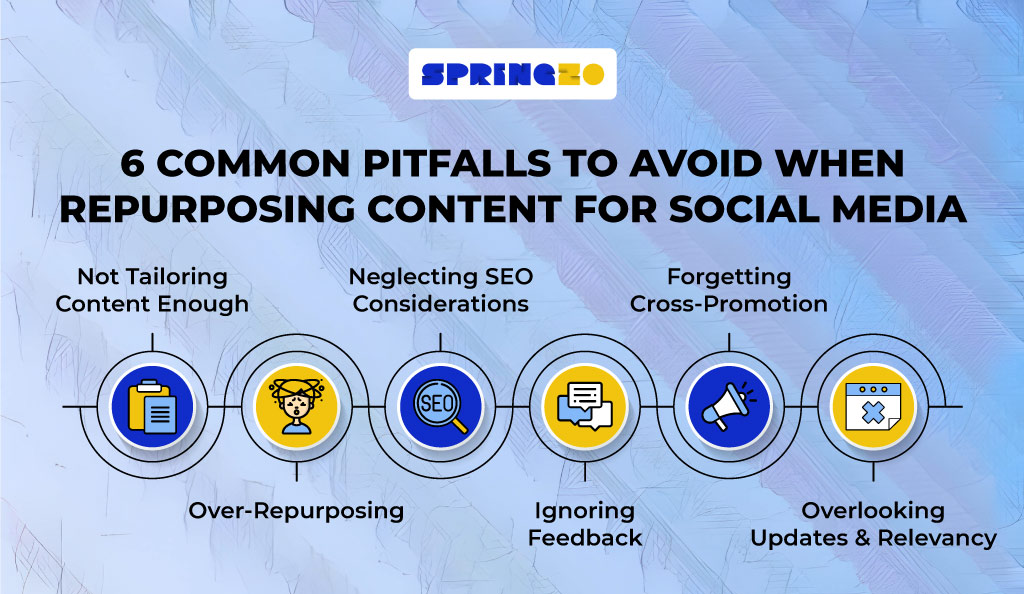
Being aware of these common mistakes can help you steer clear of them, ensuring a smoother, more effective content adaptation journey.
1. Not Tailoring Content Enough
Mistake: Simply copying and pasting content across platforms without considering each platform’s unique audience and format.
Example: Sharing a 10-minute video directly from YouTube to Twitter without cutting it into shorter, engaging snippets for the Twitter audience.
2. Over-Repurposing
Mistake: Overloading all social platforms with repurposed content and overshadowing original content, leading to audience fatigue.
Example: Transforming a single blog post into 10 different content pieces and sharing them all within a short timeframe, causing repetitiveness.
3. Neglecting SEO Considerations
Mistake: Producing multiple pieces of content on the same topic, targeting the same keywords, leading to self-competition on search engines.
Example: Creating multiple articles from one original piece and targeting the same keyword, confusing search engine crawlers.
4. Ignoring Feedback
Mistake: Continuing to repurpose content in a particular format despite clear audience feedback indicating disinterest or dissatisfaction.
Example: Persisting with turning podcast episodes into long-form LinkedIn articles when engagement metrics and comments indicate a preference for shorter, more visual content.
5. Forgetting Cross-Promotion
Mistake: Not informing followers on one platform about the existence of repurposed content on another, missing out on potential cross-platform traffic.
Example: Sharing a detailed infographic on Pinterest without letting your Twitter followers know it exists or forgetting to promote a YouTube video breakdown of a blog post on Facebook.
6. Overlooking Updates and Relevancy
Mistake: Repurposing content that’s outdated or no longer relevant, damaging brand credibility.
Example: Sharing data or statistics from 2018 in a 2023 Instagram post without context or updates.
When repurposing content for social media, it’s essential to balance amplifying your content’s reach and ensuring it remains fresh, relevant, and platform-specific.
7 Pro Tips for Maximizing the Impact of Repurposed Content
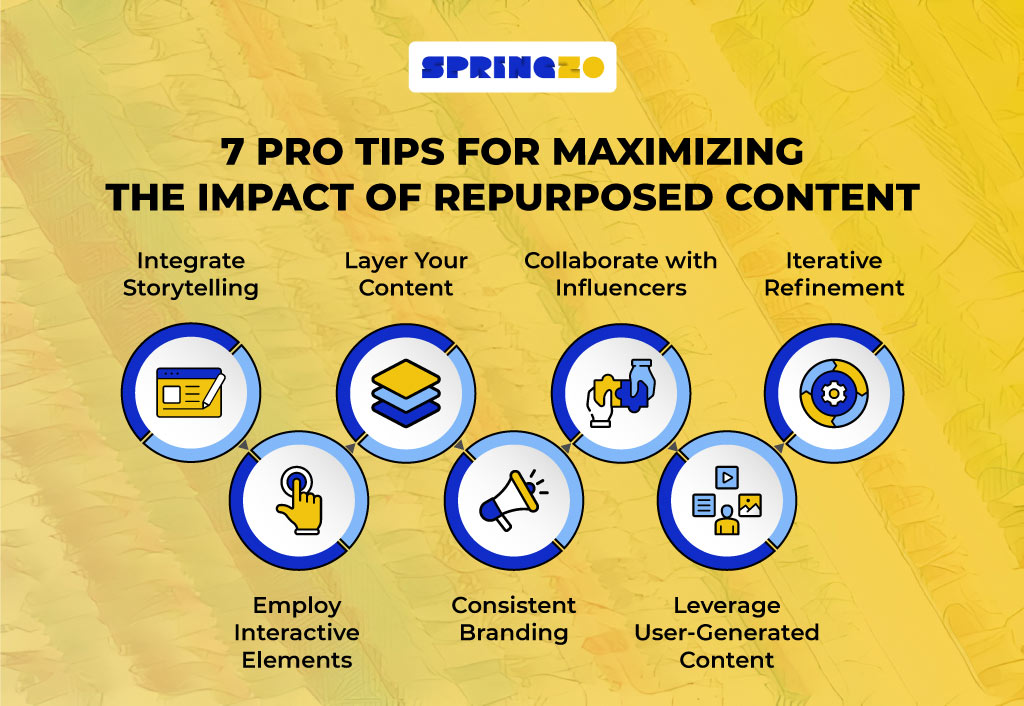
Here are advanced insights that seasoned content marketers swear by.
1. Integrate Storytelling
Regardless of the platform or format, storytelling remains a powerful tool for audience engagement. When repurposing content, weave a cohesive narrative that aligns with your brand voice and ethos.
Example: Instead of simply posting statistics from a report, craft a narrative around its findings. Share success stories, struggles, and lessons, providing a context that resonates with your audience.
2. Employ Interactive Elements
Leverage interactive tools to engage users with your repurposed content further. This could be through polls, quizzes, challenges, or even simple Q&A sessions.
Example: After sharing an infographic on Instagram, use the ‘questions’ sticker in Stories to quiz your followers about the content or gather their opinions on the subject.
3. Layer Your Content
Think of repurposing content for social media as creating a layered content experience. Begin with a teaser, delve into the core content, and conclude with a deep dive or a call to action.
Example: For a webinar, start with promotional teasers on Twitter, stream the webinar on Facebook Live, and later share behind-the-scenes or Q&A snippets on Instagram Stories.
4. Consistent Branding
Ensure that all repurposed content retains consistent branding elements. Uniformity reinforces brand recognition, whether it’s a specific color palette, logo placement, or brand voice.
Example: If a YouTube tutorial is adapted into a Pinterest how-to graphic, ensure consistent fonts, colors, and logos are utilized.
5. Collaborate with Influencers or Industry Experts
Elevate the authenticity and reach of your repurposed content by collaborating with influencers or industry leaders. Their unique perspective can add value and draw in a broader audience.
Example: If repurposing a podcast episode featuring an expert interview, collaborate with that expert to co-create short video snippets or quote graphics for sharing on their and your social platforms.
6. Leverage User-Generated Content (UGC)
According to Search Logistics, 79% of people say UGC heavily influences their purchasing decisions. Incorporate feedback, testimonials, or user-created content into your repurposing strategy. UGC not only authenticates your brand message but also fosters robust community engagement.
Example: If customers share photos using your product, repurpose these into a testimonial collage or showcase them in a “Customer Spotlight” segment on various platforms.
7. Iterative Refinement
The process of repurposing content should be iterative. Regularly revisit and refine your strategy based on analytics, audience feedback, and evolving platform algorithms.
Example: If infographics shared on LinkedIn don’t garner engagement, consider experimenting with different designs and content lengths or shifting the focus to another platform.
Unlock Your Content’s Full Potential with Springzo
The strategy of repurposing content for social media shines as a beacon of efficiency. It extends content life, engages diverse audiences, and enhances brand visibility. Mastering content repurposing empowers you to break through the content clutter, captivate your audience, and deliver your message effectively.
And at Springzo, we understand the intrinsic value within your content reservoir. We’re here to assist marketers, businesses, and creators like you in navigating the intricacies of content repurposing.
Whether you’re reimagining video content, transforming written assets into captivating visuals, or distilling extensive narratives into bite-sized, shareable moments, Springzo offers the expertise, resources, and vision to be your trusted guide.
Reach out to us today, and let’s get started!
Frequently Asked Questions (FAQs)
1. How can I ensure my repurposed content remains fresh and relevant over time?
To keep repurposed content relevant, set up a content maintenance schedule. Regularly update statistics, facts, and information to reflect the latest trends and developments. Additionally, monitor audience feedback and industry changes to adapt your content accordingly.
2. Does content repurposing work for all industries and niches?
Yes, content repurposing is a flexible strategy that can be applied across various industries and niches. Whether you’re in technology, fashion, healthcare, or any other sector, the key is understanding your specific audience and tailoring the repurposed content to meet their preferences.
3. What tools or software can assist in content repurposing?
There are several tools and software options available to streamline content repurposing. These include graphic design tools like Canva for creating visuals, social media scheduling tools like Buffer or Hootsuite for planning posts, and transcription services like Rev for converting audio content into text. The choice of tools depends on your specific needs and preferences.
